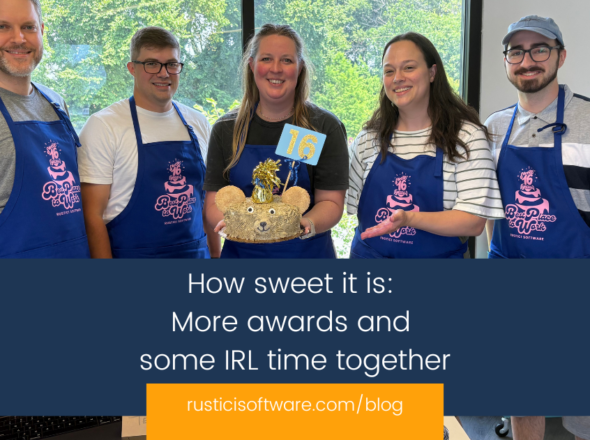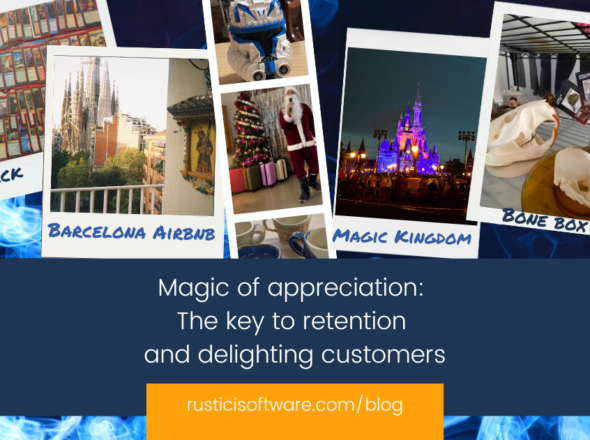If you’d like to download a pretty PDF version of this blog, click here.
Summary: Organizations often stifle behavior to reduce interpersonal conflict, thereby creating a sterile, uncreative, lifeless work environment. Interpersonal conflict caused by varied personalities is a real problem as organizations grow. The solution isn’t to stifle behavior, but rather to hire for tolerance. Allow people to be themselves at work and hire people who can respect others for who they are. Tolerance of disparate personalities directly translates to tolerance of disparate ideas and creates a culture where ideas can be freely exchanged and creativity can thrive.
Tolerance: The Key to a Fun and Innovative Workplace
I have a new theory about what makes Rustici Software a great place to work.
Rustici Software recently added a lot of new people and we are at the point where we start to see occasional friction because of personality differences. That’s a natural result of growth.
As I talk with my peers who own similarly sized companies, they all complain of having much more interpersonal conflict than we do. I started to wonder why. What do we do differently? How do we manage to have very different personalities peacefully coexist?
The Problem
As we near 50 people, we are at a stage where we need to implement more policies and have more guidelines that express who we are and who we want to be. Writing this guidance in a universally applicable way is really hard. It forces a lot of introspection about who we want to be and what we want to value. I think this is where a lot of organizations can start to go wrong.
It’s very tempting at this stage to address every problem with a policy. When there’s conflict, decide on the “right” answer and write it down for all time. Without significant consideration, it is very hard to define “right” under every possible circumstance. I think these tendencies are especially problematic for addressing interpersonal issues.
When an organization starts to experience conflict caused by personality differences, the first instinct is often to restrict behavior. If broad differences in behavior cause friction, then limiting behavior to a narrow band should reduce conflict, right? That seems logical, and it often works, but I think it’s the wrong approach for building a company that fosters innovation. I think we’ve been successful by adopting an opposite approach, as I will explain here.
Circles of Behavior
People have a range of different behaviors and beliefs that comprise their personality traits. You can model each personality trait as a continuum or as a line. Take political beliefs as an example:

Politics is an easy one because of its obvious left/right orientation, but you can model other beliefs and behaviors on similar lines. There are thousands of different personality traits that we could map this way to illustrate the broad spectrum of human diversity.
In a normal population of everyday people, individuals exist throughout each of these axes, probably with something approaching a bell curve distribution. In our day-to-day lives, we routinely encounter people throughout these ranges. Along these dimensions, there is often no inherently right or wrong position, there are just different opinions, styles and values.
A given person’s personality trait is represented by a range on the overall trait line. In different situations his/her exhibited behavior or attitude might vary, but a person’s behavior generally falls within a set range.
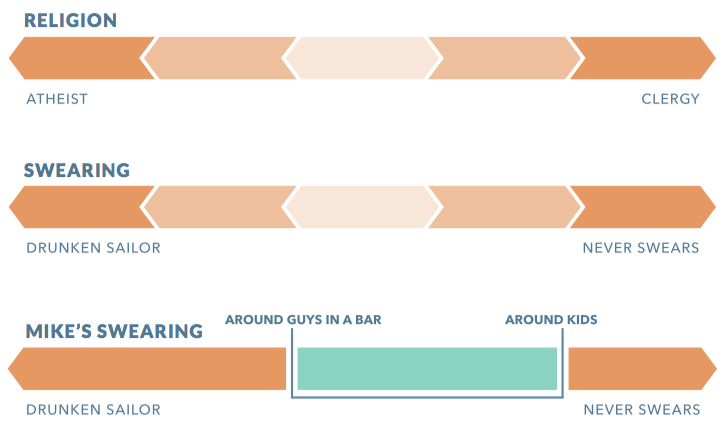
Bringing all axes together:
The circle of personality possibility
If you bring together all of these many axes, you can model the totality of human behaviors as a circle:

You can then plot a given person’s tendencies on each of their axis to create some kind of amorphous shape within the circle. Let’s call this shape the person’s Circle of Behavior.

Organizational Circles
Typical organizations seek to eliminate conflict by reducing the allowable circles of behavior. If everybody confines their behavior to a small, sanitized, politically correct circle of behavior, then the possibility of organizational conflict is minimized because exhibited behaviors are never at an extreme distance from one another.
In many situations, this approach works quite well. In international diplomacy, where the risk of inadvertent offense is high, a tight circle of behavior makes a lot of sense. In companies that thrive by providing uniform experiences to all customers or that are otherwise highly process oriented, specifying many aspects of behavior can make a lot of sense.
A tight circle of behavior is not the right approach for a company that thrives on innovation and creativity. It is not the right approach for a company that wants to attract and retain talented people who like to think for themselves. It’s not the right approach for a company that wants work to be fun.
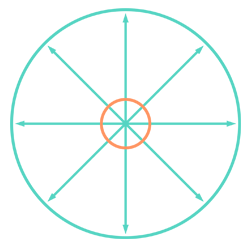
When you limit people’s behavior, you stifle them. When people don’t feel like they can be themselves, you take the joy out of their being. You create robots that go through the motions. A sterile, uniform environment is the arch nemesis of creativity, innovation and, even more importantly, happiness.
The most creative people, the people with the big ideas, are people with big personalities that don’t fit neatly into a tight circle of behavior. These people have big, crazy wide, funny shaped circles of behavior that make them truly unique individuals. To put these people in a tight box is a shame, it denies them a full expression of their inner being; it’s akin to putting a wild animal in a cage at the zoo. Sure, they may get some work done, but they won’t stick around for long and their work will never live up to its full potential.
Innovation doesn’t happen in a uniform environment. Innovative ideas are born from the confluence of different perspectives. The creative process requires healthy conflict, tension and a free flow of diverse opinions formed from varied perspectives. It’s harder for an organization to think outside the box when it puts everybody into a box.
At Rustici Software, we value creativity. Our company succeeds because of its innovation. Without innovation, we have nothing. To facilitate innovation, we want to allow for the broadest possible circle of behavior.
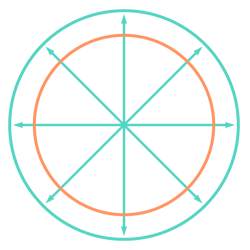
We want to enable the broadest possible circle of behavior, but we also need to acknowledge that there are behaviors that are simply not acceptable, much less desirable in society or in the workplace. A broad circle of allowed behavior absolutely does not include things like violence, harassment, bullying, illegal activities or anything else that falls outside the realm of socially acceptable behavior. The overall circle of behavior has an outer ring at the extremes of behavior ranges that society nearly universally condemns.
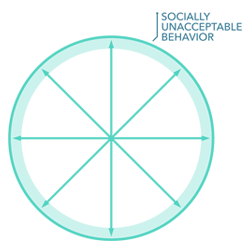
Within the circle of socially acceptable behavior it is hard, if not impossible, to pass judgement on the right way to live one’s life and we should seek to embrace all people who conduct life within this circle.
An organization seeking innovation should aspire to a broad circle of behavior, but I don’t think this circle should quite approach the size of the socially acceptable circle. A company’s circle should be broad, but probably shouldn’t stray too close to the boundaries of socially unacceptable. The ideal circle is somewhere in this vicinity.
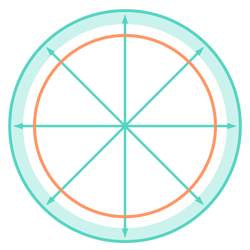
The Key – Broad Circles of Tolerance
So how do we create an organization with diverse behaviors that isn’t riddled with personal conflict and strife?
The answer lies in hiring for tolerance.
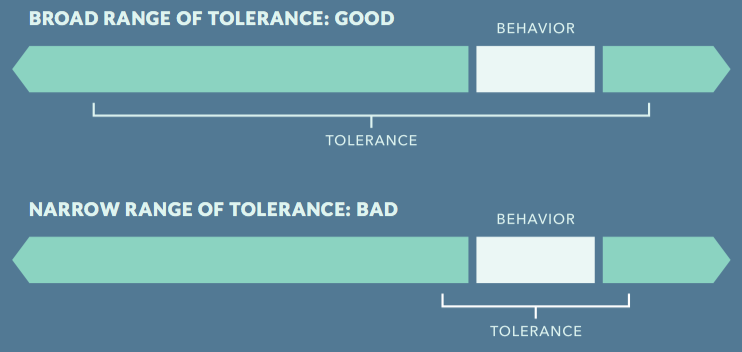
On each behavioral line, there is a range of exhibited behaviors, but there is also a separate range of behaviors that the person can tolerate. While the person may not agree with or exhibit behaviors outside of their range, the person can still maintain respect for those who do.
These many ranges of behavioral tolerance can be similarly plotted into a circle.

We hire for broad circles of tolerance.
Instead of seeking to restrict behavior, we seek to maximize tolerance, respect and understanding.
When we look to hire people, we don’t focus on their circles of behavior, or rather, we do, but we want them to be big and interesting while staying well within the line of socially acceptable.
Rather, we focus on their circle of tolerance.
We don’t care if a person has strong or different opinions, those are an asset. BUT that person does unequivocally need to respect a person with the opposite opinions enough to have intelligent, unemotional, non judgemental discourse about the topic.
Broad Tolerance in Action
Tolerance and behavior aren’t limited to social behavioral issues. The same characteristics apply directly to the nuts and bolts of our work.
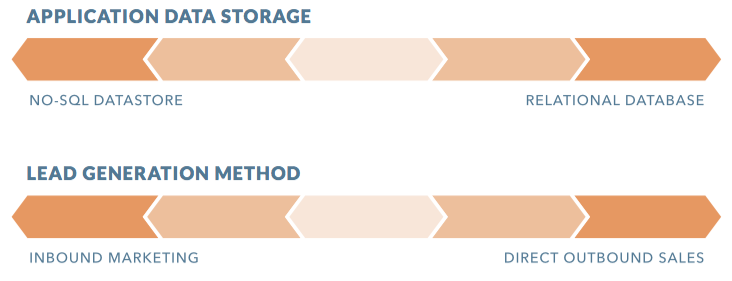
We encourage people to have “strong opinions, loosely held” when it comes to deliberating our business strategy or technical implementations.
We want people to have big ideas and to argue for their merits (broad behavior). But we also want them to acknowledge the validity of the other side and accept an alternative idea of greater merit (broad tolerance).
We insist that people deliberate with the “assumption of positive intent”. People are free to disagree with others’ ideas, but they should do so with an open mind and assume that the other person is honestly arguing with the best intent of the company in mind.
People with wide circles of behavior and tolerance know how to argue productively and produce great ideas.
Advanced Tolerance
Respect is the other side of tolerance and an important piece of this puzzle. We want people to express themselves, but they can’t hide behind tolerance as an excuse for behaving badly or disrespecting their colleagues. They can’t say “I know what I just did was horribly offensive/harmful/insulting to you, but it’s ok because you need to tolerate me”. If one is to expect tolerance, one must also practice respect.
The most tolerant person actually tolerates the intolerance of another. Advanced tolerance requires a knowledge of your audience and your surroundings. If you know that your audience skews to one side or another, then practicing advanced tolerance suggests you skew your behavior to that side of your range.
Tolerant people practice empathy. They seek to understand the people around them and how those people view the world. Tolerant people seek to interact with others in the way they want to be interacted with.
The Result
This culture is a recipe for a great organization. We have a lot of fun and a lot of laughs.
People are free to express themselves so we can bring diverse ideas together to form creativity and inspiration.
Business is filled with unknowns. In an environment permeated with a culture of respect, we empower people to form their own opinions and to argue for them based on their merit. We can hold intelligent debate and discourse unencumbered by interpersonal conflict and drama.
Personal conflict does arise, but we deal with it openly like mature adults. We presume the positive intent of our coworkers and seek to understand their perspective in lieu of passing judgement.
The people at Rustici Software are how I’ve achieved my most important business goal, looking forward to Monday morning. We have an amazing group of big, fun personalities and we somehow manage to all come together and write some pretty amazing software.
